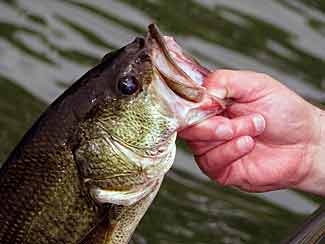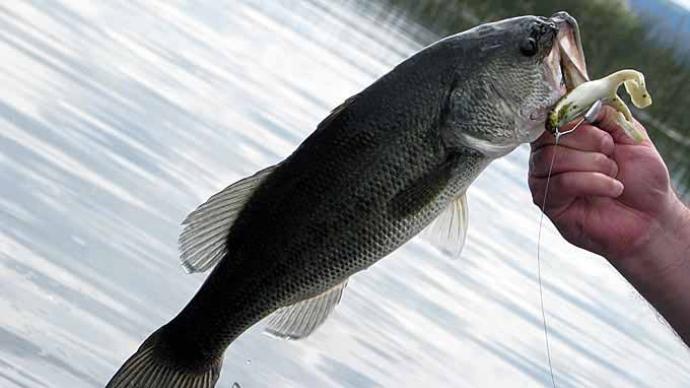| For More Information: |
Prespawn
The early spring months are often considered the best for bass fishing because it is one of the easiest times to catch largemouth bass. They will start to move up from deep water when the water temperature starts climbing above the 45 degree mark. Keep an eye on the weather. Warm rain warms up a lake faster than air temperature. Generally you will find largemouths in 2 - 12 feet of water. Start fishing for bass in the early spring in the Northwest corner of the lake or reservoir, where the water temperature will be slightly warmer than elsewhere on the lake. Concentrate on outside structure off spawning flats (points, logs, humps, rocks etc.). Look for bass in shallow creek arms with wood and weed cover after a warm rain. Other bass will still be deeper, associated with river channel points.
Baits for Prespawn
Fish the first emerging weeds and grasses with large spinnerbaits and jigs. Slow roll a spinnerbait over structure and flip and pitch the heaviest cover you can find. A stop and go retrieve with large crankbaits and spinnerbaits can be deadly.
When Do Bass Spawn?

When the water temperature is between 55 and 65 degrees, largemouth bass will seek out a shallow, protected area for spawning. Lakes, especially the larger ones, don't warm up uniformly. Therefore, not all bass will spawn at the same time. Generally, the Northwest side of lakes and the upper areas of reservoirs warm up first. The spawning area must have direct access to the sun's rays, so look for shallow flats protected from rough water. This spot is usually within 10 feet of shore in depth ranging from 1 to 6 feet. The male chooses a site that is easy to defend, near a pocket of bulrushes, next to a sunken log or a boulder, and within easy access to deep water. In addition, the male will not build a nest within 30 feet of another visible spawning nest. Occasionally, bass nests will be closer together, but only if they are not in a direct visual line with each other. The nests look like black or white patches (depending on bottom make up). Generally speaking, the bigger the bass, the deeper the water and the earlier they will spawn.
Baits for the Spawn
Fish spinnerbaits and soft plastic baits in reedbeds. Topwater baits work best on the outside edges of reedbeds, secondary points, over cover and over beds. After a cold front moves through, bass will not seek deeper water, they move into heavy cover. Therefore flip the cover with jigs and worms.
If you're getting bit but not hooking up, you're probably attracting bedding bass that are just moving the bait, but not taking it. Use gitzits to catch bass off beds. When a bass angles down to your bait on a bed, watch his pectoral fins. If they're "revolving" and/or the fish turns a lighter shade of green (i.e. brighter), he's going to bite. Use bright baits on beds because bass don't care about the color. You need to see the bait and the strike so use a bright color. Use a 5-inch reaper when bluegill are spawning (usually during and just after bass spawn).
Post Spawn
If the beds are empty, fish points and drop-offs near flats and search for suspended bass. Post spawn bass typically are tough to catch. They spend the first two weeks after the spawn recuperating. After that, they start feeding again. Post spawn generally doesn't happen to an entire lake or at the same time due to differences in water temperature. Use a topwater bait such as a Zara Spook, even if they're 20 feet deep. Bass will also suspend under floating docks and log booms just after the spawn. Use a jerkbait, then use a jig on the second pass.
Summer
As the water temperature climbs into the 80s or 90s, largemouths must conserve their metabolic energy, and will move around less. Look for them to associate strongly with cover in 1-20 feet of water, where they can hold and ambush prey. Reservoir and lake bass move off-shore to deeper channel ledges, points, open water rockpiles, and drop-offs, where they await schools of baitfish and intercept them as they pass. Just how deep they go depends on particular factors of each lake or reservoir - current, structure, temperature, oxygen, and availability of food. The larger fish tend to go into deeper waters, while the smaller fish may stay in relatively shallow areas. Even in the heat of midsummer, however, bass often return to shallow waters to feed in the early morning, evening, and late hours. Even so, they are rarely found in shallow waters in the middle of the day, especially when the sun is bright and the wind is calm. Schooling behavior begins to occur as bass feed heavily in short bursts, then move back to their holding stations to conserve energy.
This is the time of year when a bass' attention is focused on feeding. Therefore stock your tacklebox with crankbaits, jigs, spinnerbaits, worms, spoons, topwaters and finesse lures. Search for submerged weedlines with your depthfinder and concentrate on the inside edges in the morning and outside edges in the afternoon - the more erratic the edge the better. Look for isolated patches of weeds and fish those first. Fish all types of weeds until a pattern is developed. Bass will be in an ambush mode, and won't chase your lures. Therefore fish parallel to the structure. Use a rattletrap over these areas in the morning, then switch to small worms as the day progresses. Topwater baits can produce all day long, especially on overcast days. Lily pads, algae, matted weeds, and other heavy cover are bass magnets. Fish these by either scooting a frog, rat or spoon over the top or punch through with a heavy jig or worm. If it's windy, focus on the windy side of structure. Plankton is blown there which attract the baitfish which in turn attract the bass.
Fall
Bass become more active as the water cools back into the low 70s and 60s and will attack a faster-moving bait, such as a crankbait. Fish on long, tapering points with a deep-water access; some bass will be shallow and some still deep, and a long point interfaces with both environments. Boat docks and similar shallow structures offer good fishing during the fall. River channel bars and ledges provide places for the bass to feed on baitfish. And most bass tournaments held in fall are won along channel edges in the far back ends of creeks. Search for steeper shorelines, vertical drop-offs and green weeds. Topwaters are still a good choice as are spinnerbaits, jigs and oversized crankbaits. As it gets colder, slow down your presentation and downsize your lures. Flip jigs and plastics on remaining green weeds and drag plastics on deep outside breaks.
Winter
Largemouth fishing is typically slow in the winter but it's a good time to catch a big fish. Fish in shallow lakes and concentrate on dense, shallow cover with slow-moving lures like jigs. Look for deep suspended bass on river channel drop-offs and submerged stumps. Focus on the base of deep drops and green weedlines. Fish slowly using a vertical presentation with jigs and spoons. Fish smaller baits for largemouths during cold weather than you might fish at other times. Their metabolism has slowed to the extent that they feed less often and take smaller bites when they do.



